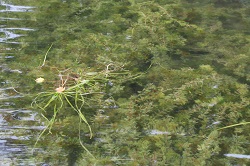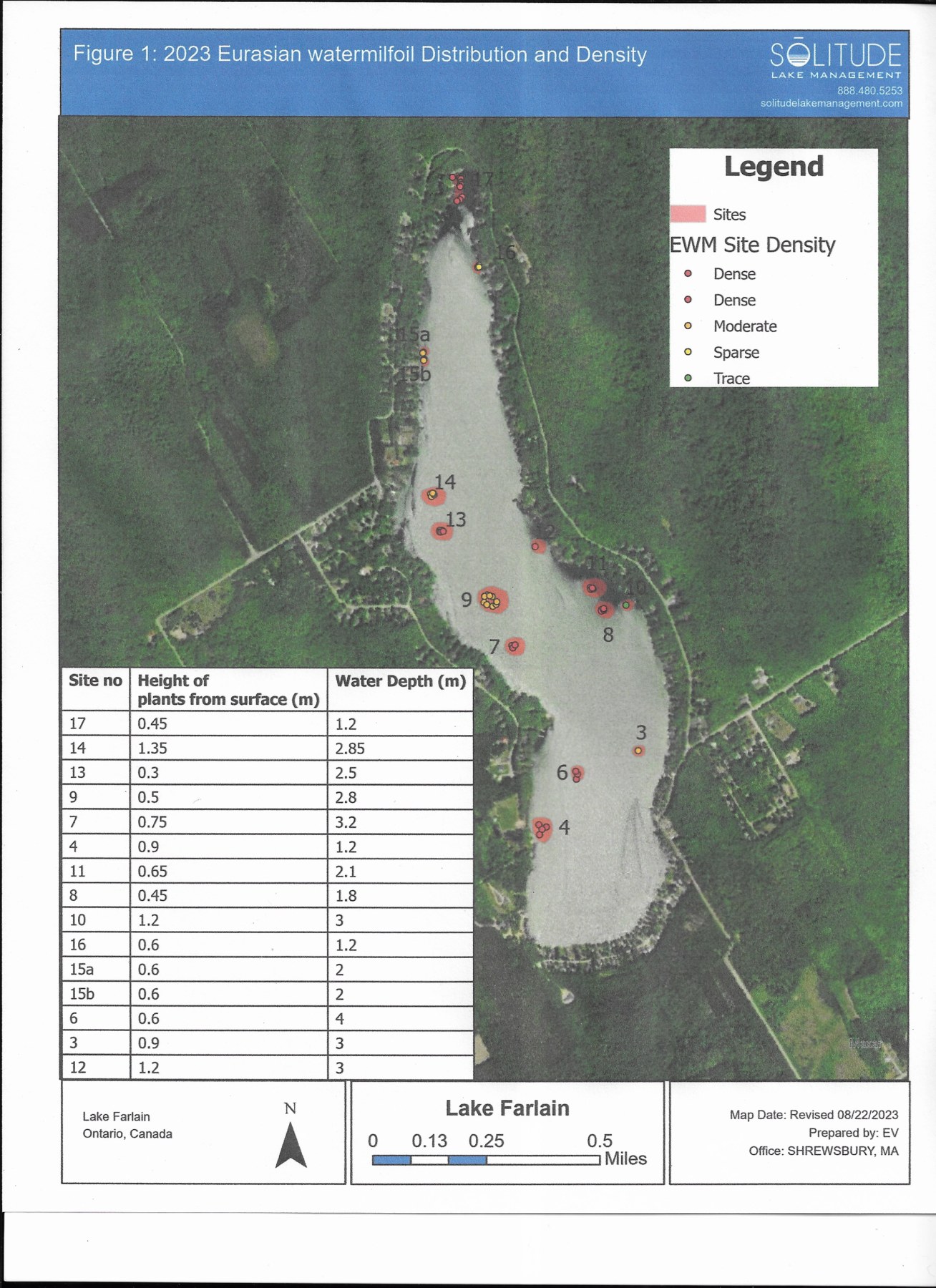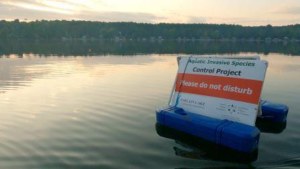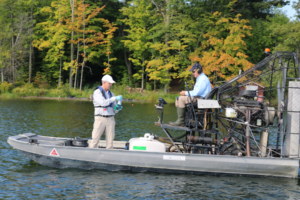
FLCA Receives Ontario Trillium Foundation Grant
Eurasian Watermilfoil – Dealing with the Threat
The FLCA was fortunate that in 2018, the Ontario Trillium Foundation, an agency of the government of Ontario, approved our application for a grant to help us with our efforts to control the spread of Eurasian Watermilfoil (EWM) in Farlain Lake for three years covering the period ending 2021! Due to COVID restrictions and our inability to fully implement our management plan in 2020 and 2021, the period was extended to the end of 2022. Various limitations restricted our project again in 2022 and we sincerely appreciated OTF extending our grant to the end of 2023. Over the past five years, we have worked hard to develop strategies to control the infestation of this very aggressive aquatic plant based on extensive research, consultation, networking and experience. The grant has significantly helped provide us with the financial resources we needed to purchase equipment, supplies and services to manage the EWM and protect the future of our lake. It’s hoped that our learning and experience will also help other communities dealing with the EWM. An outline of our past efforts and our experience with a new herbicide in 2023 are described below.
What is the Eurasian Water Milfoil (EWM)?
EWM is an extremely aggressive non-native invasive water plant that forms thick underwater stands of tangled stems and vast mats of vegetation on the water’s surface, especially in shallow lakes like Farlain Lake. It was discovered in Farlain Lake in 2012 during a FLCA aquatic plant study of the lake. It had not been observed by Ontario government organizations studying water quality or the fisheries of the lake prior to that. The pioneer colony (original infestation) was limited to a small isolated area less than one acre in size on the southwest shoreline of the lake.
EWM is considered one of the most widely distributed aquatic invasive species with records of EWM confirmed in 47 continental USA states as well as the provinces of British Columbia, Ontario, and Quebec. Various organizations have been combatting EWM for years. For example, Lake George in New York State’s Adirondack Park has been managing EWM for 32 years. The Okanagan Basin Water Board in British Columbia has been combatting EWM for the past 40 years. Control budgets vary depending on the severity of the problem and the size of the water body. For example, the Christina Lake, British Columbia, EWM control program is $213,000 annually. To manage EWM and improve the lake’s water quality in Puslinch Lake Ontario, through dredging the annual operating cost is approximately $150,000.
EWM will grow from plant fragments created from physical breakage by boaters, anglers, and other disturbances (e.g. forceful wave action, aquatic animals, fish, waterfowl, etc.) during the summer months. In late fall during the end of its growth period EWM becomes brittle and naturally break apart. Plant fragments are the primary means of EWM reproduction; they float on the surface and are dispersed by wind and wave actions to other areas where they sink and colonize into new plants. In optimum water temperatures (15°C – 35°C) EWM plants can grow 30 cm per week.
Why is EWM a Problem?
EWM is an extremely aggressive invasive aquatic plant that forms thick underwater stands of tangled stems and dense floating mats of vegetation.Some of the problems associated with EWM include:
Recreational activities such as boating, fishing, and swimming are impeded by dense growth at or near the surface.
Shoreline property values can be de-valued. EWM choked bodies of water can depress real estate values up to 20%.
The lake’s ecosystem will be altered. EWM will displace important native plants thus harming fish and wildlife habitat. Dense floating vegetation becomes breeding habitat for mosquitoes.
Stagnant oxygen-depleted conditions are often found in association with dense beds of EWM. Sudden nutrient release caused by late-season die-back of extensive plant beds may cause nuisance algae blooms.
Costs to manage EWM growth are borne by either local citizens, lake management organizations, and/or local governments.

What is the FLCA Doing to Manage the EWM?
The FLCA implemented a EWM Control Program in 2014 under the leadership of the EWM Team working with the FLCA Board, and with the support of many volunteers from the community. We also appreciate the ongoing support we receive from the Severn Sound Environmental Association (SSEA) and the Township of Tiny.
Our current work on attempting to manage the Eurasian Watermilfoil is based on a series of steps starting with the development of the FLCA State of the Lake Report 2012 that then led to the LaketoSkyManagementPlanAug2013. As a result of these two documents that are due mostly to the efforts and authorship of one of our members and a past president, Peter Andrews. He discovered the EWM back in 2012 and since then has led the battle against the EWM. That included leading our EWM Steering Committee which consists of a very hard-working group of volunteers which was responsible for working with the FLCA Board on an EWM Integrated Management Plan which has formed the basis of our annual control efforts. That plan essentially includes three components: 1) application of the herbicide Reward, 2) installation of benthic mats in infested areas (bottom barriers), and 3) manual harvesting using DASH (Diver Assisted Harvesting). All of these components require authorization from various government agencies (Department of Fisheries and Oceans, Ministry of Natural Resources and Forestries, Ministry of the Environment, Conservation and Parks).
Each year we review the outcome of our efforts and develop a work plan for the following season based on the overall plan, modified based on our assessment. We’ve also worked hard on building our relationship with the local Township which has supported us in various ways, and with the SSEA – specifically its Invasive Species Coordinator, and in 2018 we were fortunate in obtaining a sizeable grant from the Ontario Trillium Foundation (OTF) to fund equipment, supplies, etc. for three years 2019-2021, now extended to the end of 2024 due to disruptions created by COVID and other issues.
Through ongoing research, we became aware of a new herbicide called ProcellaCOR which had been developed and used very successfully since 2018 in the US to eradicate the EWM in a number of lakes. Health Canada, through its Pesticide Management Regulatory Agency, PMRA, conducted a review of an application for the use of the herbicide in Canada starting in 2019 and granted registration finally in May of this year.
The Planning and Approval Process
Each year we review the sites, develop a report and draft management plan for the following year which must then be submitted to the Department of Fisheries and Oceans (DFO), and copied to the Ministry of Natural Resources and Forestries (MNRF) and the Ministry of the Environment, Conservation and Parks (MECP). That was completed this year by January 2023. Authorization to implement our management plan for the following year is required first from DFO, and then a permit for the application of a herbicide must be obtained from MECP.
We received approval to proceed with the application of the new herbicide ProcellaCOR to the infested areas on the lake this year received the required permit from the Ontario Ministry of the Environment, Conservation and Parks (MECP). The application of ProcellaCOR was completed on September 6, 2023. This was the culmination of over 6 months of ongoing, relentless communication with DFO and the MECP by our EWM Team.
About ProcellaCOR and the Treatment Application

Preparation
 Shoreline property owners near the infestation sites were notified of the plans for treatment and no major concerns were received. The FLCA used elerts, signage and Facebook to communicate plans to members. Members of the community were invited to send any comments, questions or concerns in to us at the FLCA general email box at inquiries@farlainlake.ca.
Shoreline property owners near the infestation sites were notified of the plans for treatment and no major concerns were received. The FLCA used elerts, signage and Facebook to communicate plans to members. Members of the community were invited to send any comments, questions or concerns in to us at the FLCA general email box at inquiries@farlainlake.ca.Buoys marking the sites to be treated were placed on the lake a few days in advance of treatment. The markers were removed immediately following the application. The EWM team reviewed all the sites and took images with our underwater drone to establish a baseline for the purpose of evaluating the effectiveness of the herbicide.

The application of ProcellaCOR must be done by a licenses applicator specifically trained for this particular herbicide. Currently there are no trained licensed applicators for this product available in Canada given that it has only just been approved for use in this country by Health Canada. The application also requires particular equipment as seen in this photo taken during the treatment on Farlain Lake.
Advisory Recommendations for Lake Water Use Following Treatment
- Do not use treated water for irrigation of greenhouse vegetables and fruits;
- Do not use treated water for hydroponic irrigation without activated charcoal or similar filtration.
- Do not use treated water for irrigation of residential gardens, turf grass, landscape vegetation or other non-food irrigation for 5 days after application.
- Do not use treated water for irrigation of commercial field crops until concentrations are analytically below 2 ppb.
What to Expect Following Treatment
The Results and What’s Next
 Approximately 4 weeks later on October 4, the EWM team and Dr. Heilman reviewed the treated sites, checking the status of both the invasive plants as well as the surrounding native plants. Many photos and videos were taken during the treatment. The findings more than met expectations – the EWM was dying and the native plants appeared untouched and healthy as seen in these two photos taken that day.
Approximately 4 weeks later on October 4, the EWM team and Dr. Heilman reviewed the treated sites, checking the status of both the invasive plants as well as the surrounding native plants. Many photos and videos were taken during the treatment. The findings more than met expectations – the EWM was dying and the native plants appeared untouched and healthy as seen in these two photos taken that day.Since then a very comprehensive report was completed thanks in particular to Peter Andrews with input from our EWM team and Dr. Heilman. The FLCA 2023 EWM Management Year End Report can be downloaded here. SOLitude also completed a report for submission to the MECP as required. We are in the final stages of merging the two reports and will post that here as soon as it is available for those who would like to review the more technical aspects of the treatment. Farlain Lake is the first inland lake in Canada to be treated with the newly registered ProcellaCOR FX by a licensed applicator certified by SePRO for ProcellaCOR FX.. SePRO has produced a video reflecting our project as part of its Lakes and Ponds Heroes program. You can watch the video by clicking on this link.
The work didn’t stop there. The 2024 work plan was submitted to DFO and MECP based on the 2023 project and results seen in the fall. Approval was received for the application of ProcellaCOR again in 2024 if needed. The Farlain Lake 2024 EWM Integrated Management Plan Final is available here to download for your information. The focus was on continued evaluation of the results of the 2023 treatment.
Our EWM team was out in May of 2024 to survey the sites. We were thrilled to find that there was no sign of the EWM at any of the sites and that the native plants appeared untouched. A SOLitude biologist returned to the lake in July and conducted a thorough review of the sites and confirmed no presence of the EWM. In addition to surveying the vegetation using a rake toss method, native plants were identified and recorded, a temperature (temp) and dissolved oxygen (DO) profile was collected at four sites (4, 8, 9, 17), per DFO requirements. The oxygen levels were normal or higher. The results of that review are documented in the formal report available for downloading FarlainLake2024_Report_Final.
The FLCA will continue its monitoring of the lake for any sign of the return of the EWM. There may be the need for “spot” treatments in the coming years but based on the experience in the US, it is expected that the results we’ve seen this year should continue for the next 3 years or more. Reports will continue to be submitted to the government agencies and shared with other organizations such as the Township, SSEA, FoTTSA and FOCA.
Farlain Lake is the first freshwater lake in Canada to use ProcellaCOR FX since its registration by Health Canada. We have received many inquiries to date from other lake associations struggling to manage the EWM and we are happy to share our experience, part of our commitment to the Ontario Trillium Foundation when we received our grant. Our success is due to the power of community and the incredible dedication and hard work of our EWM Team and all the “Weed Warriors”.
 A formal event was held on September 21 at the lake’s boat launch to express our appreciation to the Ontario government for the grant received from the Ontario Trillium Foundation. We were honoured to have North Simcoe MPP Jill Dunlop present to hear how the grant was used and its impact on our ability to battle the EWM.
A formal event was held on September 21 at the lake’s boat launch to express our appreciation to the Ontario government for the grant received from the Ontario Trillium Foundation. We were honoured to have North Simcoe MPP Jill Dunlop present to hear how the grant was used and its impact on our ability to battle the EWM.
The FLCA is happy to answer questions and provide additional information to share our experience with others battling this invasive plant. Simply contact the FLCA via email at inquiries@farlainlake.ca and we will respond as quickly as possible.
